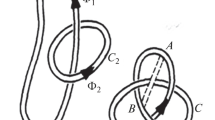Abstract
It is suggested that the downward helicity flux (through the upper boundary of the viscous turbulent boundary layer) be treated as a measure of the intensity of atmospheric vortices, including tropical cyclones, tornadoes, and dust devils. As follows immediately from the general helicity balance equation known in the literature, this flux is determined by the product of the cubed maximum wind speed and the width of the strip swept by the maximum wind during vortex movement. For intense vortices in their steady-state, mature stage, this helicity flux can also serve as a measure of the rate of helicity destruction by the forces of viscous turbulent friction. Examples of applying the introduced notion to the diagnostics of tornadoes and their classification according to a destructive force are given. A comparative analysis (according to helicity flux values) of dust devils on the Earth and Mars, on the one hand, and tornadoes, on the other, is presented.
Similar content being viewed by others
References
H. K. Moffatt, “The Degree of Knottedness of Tangled Vortex Lines,” J. Fluid Mech. 35, Part 1, 117–129 (1969).
F. V. Dolzhanskii, “On Mechanical Prototypes of Fundamental Hydrodynamic Invariants and Slow Manifolds,” Usp. Fiz. Nauk 175, 1257–1288 (2005).
M. V. Kurgansky, “Relationship between Helicity and Potential Vorticity in a Compressible Rotating Fluid,” Izv. Akad. Nauk SSSR, Fiz. Atmos. Okeana 25, 1326–1329 (1989).
M. V. Kurgansky, “Generation of Helicity in a Moist Atmosphere,” Izv. Akad. Nauk, Fiz. Atm. Okeana 29, 464–469 (1993).
M. V. Kurgansky, “Helicity Flux in a Compressible Baroclinic Atmosphere and Its Properties,” Izv. Akad. Nauk, Fiz. Atmos. Okeana 41, 8–13 (2005) [Izv., Atmos. Ocean. Phys. 41, 4–8 (2005)].
R. Hide, “Superhelicity, Helicity and Potential Vorticity,” Geophys. Astrophys. Fluid Dyn. 48, 69–79 (1989).
M. V. Kurgansky, “Helicity Production and Maintenance in a Baroclinic Atmosphere,” Meteorol. Z. 15, 409–416 (2006).
S. G. Chefranov, “On a Scale-Invariant Criterion of Similarity for Rotating Flows in Laboratory Modeling of Tornado-Like Vortices,” Izv. Akad. Nauk, Fiz. Atm. Okeana 39, 760–765 (2003) [Izv., Atmos. Ocean. Phys. 41, 685–689 (2003)].
D. K. Lilly, “The Development and Maintenance of Rotation in a Convective Storm,” in Intense Atmospheric Vortices, Ed. by L. Bengtsson and J. Lighthill (Springer-Verlag, Berlin, 1982), pp. 149–160.
D. Etling, “Some Aspects of Helicity in Atmospheric Flows,” Beitr. Phys. Atmos. 58, 88–100 (1985).
M. V. Kurgansky, Adiabatic Invariants in Large-scale Atmospheric Dynamics (Gidrometeoizdat, St. Petersburg, 1993; Taylor & Francis, London, 2002).
K. J. Mallen, M. T. Montomery, and B. Wang, “Reexamining the Near-Core Radial Structure of the Tropical Cyclone Primary Circulation: Implications for Vortex Resiliency,” J. Atmos. Sci. 62, 408–425 (2005).
H. Riehl, Climate and Weather in the Tropics (Gidrometeoizdat, Leningrad, 1984; Academic, London, 1979).
K. A. Emanuel, “Increasing Destructiveness of Tropical Cyclones over the Past 30 Years,” Nature 436, 686–688 (2005).
W.-C. Lee and J. Wurman, “Diagnosed Three-Dimensional Axisymmetric Structure of the Mulhall Tornado on 3 May 1999,” J. Atmos. Sci. 62, 2373–2393 (2005).
R. B. Smith, “A Hurricane Beta-Drift Law,” J. Atmos. Sci. 50, 3213–3215 (1993).
J. Wurman, C. Alexander, P. Robinson, and Y. Richardson, “Low-Level Winds in Tornadoes and Potential Catastrophic Tornado Impacts in Urban Areas,” Bull. Am. Meteorol. Soc. 88, 31–46 (2007).
A. I. Snitkovskii, “Tornadoes in the USSR,” Meteorol. Gidrol., No. 9, 12–25 (1987).
I. A. Pisnichenko, “Role of Phase Transitions of Moisture in Processes of Tornado Formation,” Izv. Akad. Nauk, Fiz. Atmos. Okeana 29, 793–798 (1993).
M. Balme and R. Greeley, “Dust Devils on Earth and Mars,” Rev. Geophys. 44, RG3003 (1–22), doi: 10.1029/2005RG000188 (2006).
H. B. Bluestein, “Tornadoes,” in Encyclopedia of Climate and Weather, Ed. by S. H. Schneider (Oxford Univ. Press, New York, 1996), Vol. 2, pp. 764–768.
Author information
Authors and Affiliations
Corresponding author
Additional information
Original Russian Text © M.V. Kurgansky, 2008, published in Izvestiya AN. Fizika Atmosfery i Okeana, 2008, Vol. 44, No. 1, pp. 67–74.
Rights and permissions
About this article
Cite this article
Kurgansky, M.V. Vertical helicity flux in atmospheric vortices as a measure of their intensity. Izv. Atmos. Ocean. Phys. 44, 64–71 (2008). https://doi.org/10.1134/S0001433808010076
Received:
Accepted:
Published:
Issue Date:
DOI: https://doi.org/10.1134/S0001433808010076



